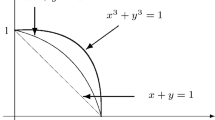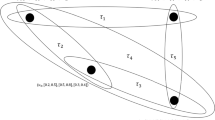Abstract
There have been only few attempts to extend fuzzy logic to automated theorem proving. In particular, the applicability of the resolution principle to fuzzy logic has been little examined. The approaches that have been suggested in the literature, however, have made some semantic assumptions which resulted in limitations and inflexibilities of the inference mechanism. In this paper we present a new approach to fuzzy logic and reasoning under uncertainty using the resolution principle based on a new operator, the fuzzy operator. We present the fuzzy resolution principle for this logic and show its completeness as an inference rule.
Similar content being viewed by others
References
Ackermann, R.,Introduction to Many Valued Logics, Dover, New York (1967).
Adams, J. B., ‘Probabilistic reasoning and certainty factors’,Math. Bios. 32, 177–186 (1976).
Baldwin, J. F., ‘Fuzzy logic and fuzzy reasoning’, in: E. H. Mamdani and B. R. Gaines (Eds.),Fuzzy Reasoning and its Applications, Academic Press, London (1981), pp. 133–148.
Baldwin, J. F., ‘Support logic programming’, A. Jones (Ed.)Fuzzy Sets, Theory, and Applications, Reidel, Dordrecht (1986).
Baldwin, J. F. and Monk, M., ‘SLOP — A system for support logic programming’,I.T.R.C. Research Report, Univ. of Bristol (1986).
Baldwin, J. F., ‘Evidential support logic programming’,Fuzzy Sets and Systems 24, 1–26 (1987).
Bellmann, R. and Giertz, M. ‘On the analytic formalism of the theory of fuzzy sets’,Inf. Sciences 5, 149–156 (1973).
Bellmann, R. and Zadeh, L. A., ‘Local and fuzzy logics’, in: J. Dunn and G. Epstein (Eds.)Modern Uses of Multiple-Valued Logics D. Reidel, Dordrecht (1977) pp. 103–165.
Bundy, A., ‘Incidence calculus: a mechanism for probabilistic reasoning’,J. Autom. Reasoning 1, 263–283 (1985).
Carnap, R.,Logical Foundations of Probability, Univ. Chicago Press (1950).
Chang, C. and Lee, R.,Symbolic Logic and Mechanical Theorem Proving, Academic Press, New York (1973).
Cohen, P.,Heuristic Reasoning About Uncertainty — An Artificial Intelligence Approach Morgan Kaufmann, Los Altos (1985).
Dubois, D. and Prade, H., ‘A class of fuzzy measures based on triangular norms’,Int. J. General Systems, 8(1) (1982).
Dubois, D. and Prade, H., ‘Criteria aggregation and ranking of alternatives in the framework of fuzzy set theory’ in: H. Zimmerman, L. A. Zadeh and B. R. Gaines (Eds.).Stud. Management Sci. 20, 209–240 (1984).
Duda, R., Hart, P. and Nilson, N., ‘Subjective bayesian methods for rule-based inference systems’, Tech. Note 124, SRI, Menlo Park (1976).
Duda, R., Gachnig, J. and Hart, P., ‘Model design in the prospector consultant system for mineral exploration’, in: D. Michie (Ed.)Expert Systems in the Micro-Electronic Age Univ. Press, Edinburgh, pp. 153–167 (1981).
de Finetti, B.,Theory of Probbility New York, Wiley (1974).
Giles, R., ‘A Nonclassical Logic for Physics’,Studia Logic 33, 313–327 (1974).
Giles, R., ‘Łukasiewicz logic and fuzzy set theory’,Intl. J. Man-Machine Stud. 8, 313–327 (1976).
Ishizuka, M., Fu, K. and Yao, J., ‘Rule-based damage assessment system for existing structures’,Solid Mechanics Archive 8, 99–118 (1983).
Ishizuka, M., ‘Inference methods based on extended Dempster and Shafer's theory for problems with uncertainty/fuzziness’,New Generation Computing 1, 159–186 (1983).
Ishizuke, M. and Kanai, N., ‘Prolog-ELF incorporating fuzzy logic’Proc. Ninth IJCAI, pp. 701–703 (1985).
Lindley, D. V., ‘Scoring rules and the inevitability of probability’,Int. Statistics Rev.,50, 1–16 (1982).
Liu, X. H., Tsai, J. P. and Weigert, Th., ‘Λ-resolution and the interpretation of Λ-implication in fuzzy operator logic’,Inf. Sci. 56, 259–278 (1991).
Łukasiewicz, J., ‘Many-valued systems of propositional logic’,Polish Logic, Oxford U.P., Oxford (1967).
Lee, R., ‘Fuzzy logic and the resolution principle’,JACM 19, 109–119 (1972).
Mukaidono, M., ‘Fuzzy Inference of resolution style’, in R. Yager (Ed.),Fuzzy Set and Possibility Theory, Pergamon, New York, pp. 224–231 (1982).
Rosser, J. and Turquette, A.,Many Valued Logic, North-Holland, Amsterdam (1952).
Savage, L. J.,The Foundations of Statistics, New York, Wiley (1954).
Shafer, G.,A Mathematical Theory of Evidence, Princeton Univ. Press (1976).
Shen, Z., Ding, L. and Mukaidono, M., ‘A theoretical framework of fuzzy prolog machine’, in: M. Gupta and T. Yamakawa (Eds.)Fuzzy Computing, North-Holland, Amsterdam (1988) pp. 89–100.
Shortliffe, E. H. and Buchanan, B. G., ‘A model of inexact reasoning in medicine’,Math. Biosci. 23, 351–379 (1975).
Shortliffe, E.,Computer-Based Medical Consultation: MYCIN, American Elsevier, New York (1976).
Weiss, S., Kulikowski, C., Amarel, S. and Safir, A., ‘A model-based method for computer-aided medical decision-making’,AI 11, 145–172 (1978).
Yager, R., Ovchinnikov, S., Tong, R. and Nguyen, H.,Fuzzy Sets and Applications, Wiley, New York (1978).
Zadeh, L. A., ‘Fuzzy sets’,Inform. Contr. 8, 94–102 (1965).
Zadeh, L. A., ‘Fuzzy logic and approximate reasoning’,Synthese 30, 407–428 (1975).
Zadeh, L. A., ‘The concept of linguistic variables and its application in approximate reasoning’,Inf. Sci. 8 199–249, 301–357 (1975),Inf. Sci. 9, 43–80 (1976).
Zadeh, L. A., ‘Is probability theory sufficient for dealing with uncertainty in AI?’ in: L. Kanal and J. Lemmer (Eds.)Uncertainty in Artificial Intelligence, North-Holland, Amsterdam, pp. 103–116 (1986).
Zadeh, L. A., ‘Commonsense and fuzzy logic’, in: N. Cercone and G. McCalla (Eds.)The Knowledge Frontier, Springer, New York, pp. 103–136 (1987).
Author information
Authors and Affiliations
Rights and permissions
About this article
Cite this article
Weigert, T.J., Tsai, JP. & Liu, X. Fuzzy operator logic and fuzzy resolution. J Autom Reasoning 10, 59–78 (1993). https://doi.org/10.1007/BF00881864
Received:
Accepted:
Issue Date:
DOI: https://doi.org/10.1007/BF00881864




